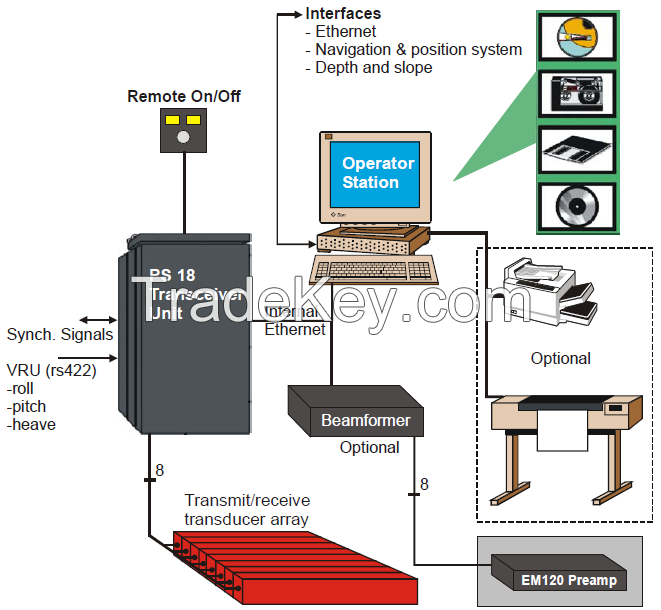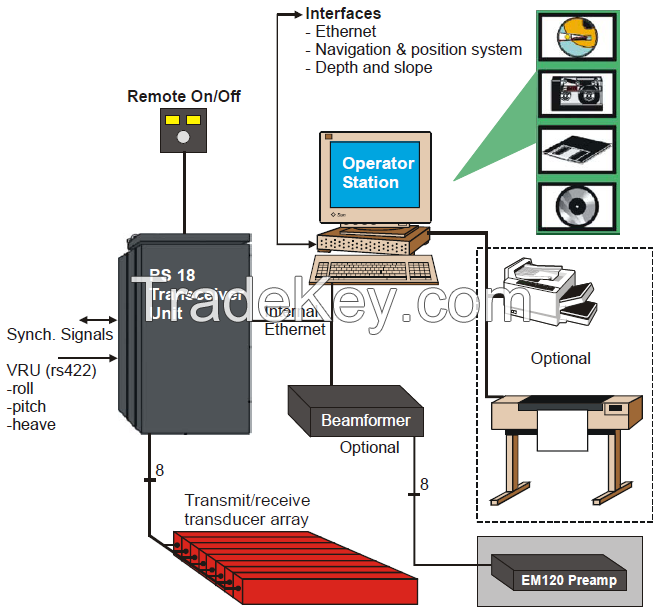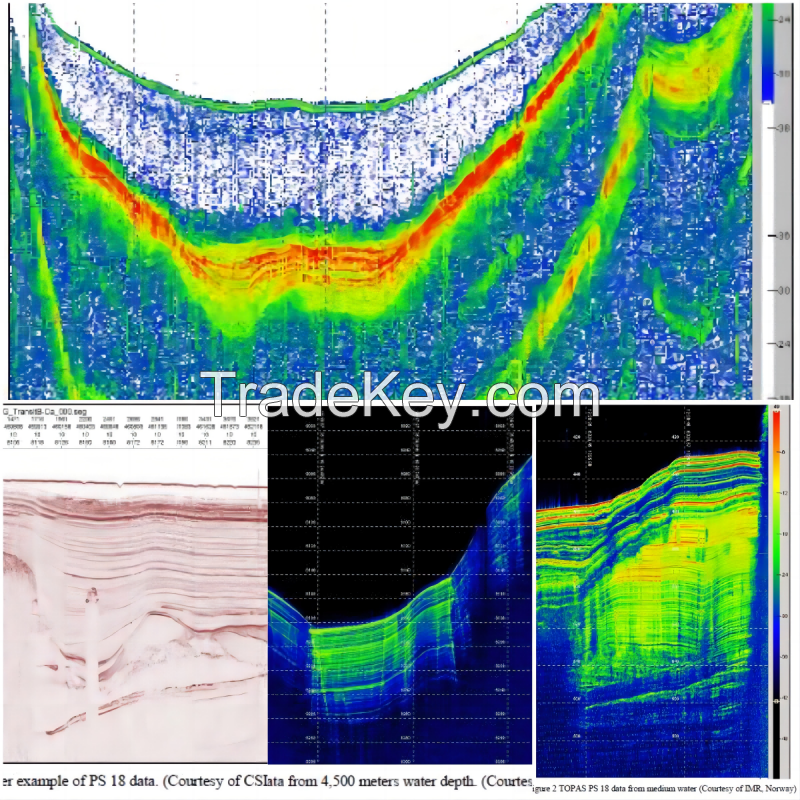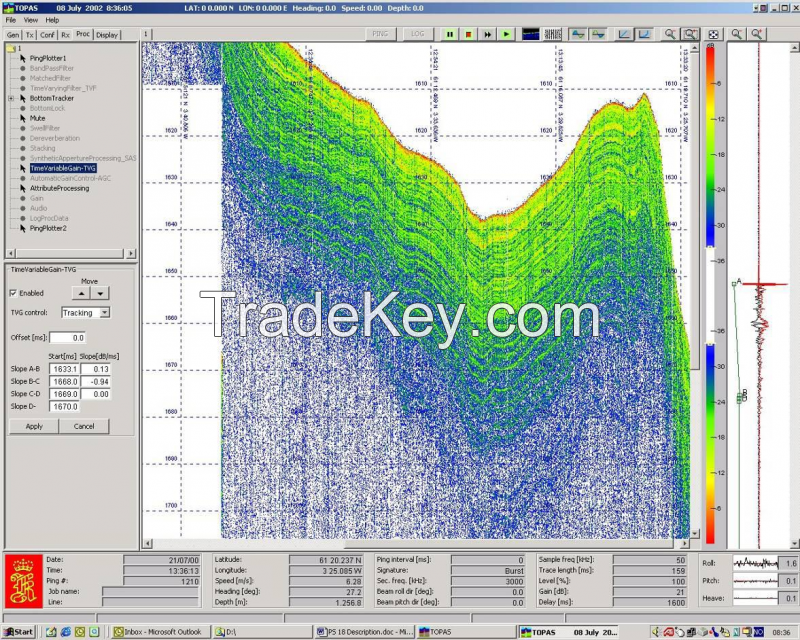

离岸价格
Get Latest Price( Negotiable )
|1 Strand Minimum Order
国:
China
モデル番号:
-
离岸价格:
( Negotiable ) Get Latest Price
ロケーション:
Yantai, Shandong Province, China
最低注文量の価格:
-
最低注文量:
1 Strand
パッケージの詳細:
Packing in cartons or wooden cases
納期:
-
供給能力:
-
支払いタイプ:
T/T
製品グループ :
TOPAS PS 18 is a hull-mounted shallow formation profiler system
with very high performance and adaptability. Its penetration is
better than that of other surface towed buzzers, and its resolution
is considerably higher. Using Ricker wave and non-envelope
detection, the resolution can reach 0.1 ~ 0.2m. There is no ringing
and thus silent masking near the reflector, especially near the sea
floor.
The TOPAS PS 18 is designed to be used in sync with other echo
detection systems, with launch intervals exceeding 2 seconds. The
higher the speed, the stronger the water noise. The TOPAS PS 18
provides high quality shallow profile data at speeds of more than
10 knots and penetrations to depths of more than 200 m.
System
highlight:
TOPAS PS 18 is a high frequency width, high sound source level,
compact design with real-time processing capability.
ï¬ Bottom installation, working water depth from 20m to full ocean
depth
ï¬ Narrow beam, wide band, with extremely high spatial
resolution
ï¬ There is no obvious sidelobe, and clear shallow profile images
can be obtained under harsh environmental conditions
ï¬ Penetration decreases linearly with range/water depth
ï¬ Operators can select transmit waveforms to optimize performance
according to different application requirements
ï¬ Monopulse (Ricker), CW, and Chirp are standard waveforms.
Interfaces to user-designed waveforms can be provided through
files
ï¬ no ringing, making the thin layer reflect clearly
ï¬ has a complete interface for sensor signal , data
processing, data display and data storage
ï¬ Roll, pitch, and heave beam stabilization
ï¬ Scanning beam steering (optional)
ï¬ receiver array with beamformers
ï¬ Slope function (from multi-beam systems)
ï¬ main frequency/resonant receiver (optional)
ï¬ off-line post-processing software
ï¬ Java software is portable
ï¬ Windows or Linux
ï¬ I/O and live data logging to SEG-Y format (rev 1)
ï¬ Raw data that can be distributed over a local area network
(LAN) for simultaneous online processing in multiple locations
ï¬ Worldwide technical support
Main
feature:
TOPAS PS 18 parametric sound source Shallow formation profiler is
suitable for high-resolution shallow formation profiling and
underwater target detection, operating water depths from 20m to
full sea depth. The ship's bottom mount, with roll, pitch and heave
beam stabilization, makes it an effective tool for a variety of
fine, high-resolution surveys. Since no towing operation is
required, survey ship speeds can reach more than 15 knots
(depending on the ship noise level).
Thanks to the use of electronic beam steering technology, the
operator can fully control the Angle of incidence of the beam on
the seabed. As a result, the "footprint" position can be precisely
positioned and the best penetration depth can be obtained. In
addition, this technology makes three-dimensional shallow strata
profiles a reality.

The TOPAS PS 18 Shallow Formation Profiler consists of three basic
units:
ï¬ Transducers
− Eight modules have 128 channels, with each module having 16
channels
− Special transducer cable with connector, length 20 m
ï¬ Transmitting and receiving unit
− Switching linear power amplifier
− Built-in T/R-switch − Data acquisition circuit
ï¬ Operator workstation
− 19-inch LCD color monitor
− Keyboard
− Mouse
− 2 GB Memory (RAM)
− >250 GB Hard disk (Raid 10)
− Read and write DVD drives
ï¬ Complete system working software
ï¬ User Manual (Installation, operation, maintenance)
The information sources necessary for the TOPAS PS 18 to work
include: ship motion sensors and GPS.
System working principle
The core of TOPAS PS 18 shallow formation profiler is the
"parametric sound source". Parametric sound source is an acoustic
emission device which utilizes the nonlinear characteristics of the
medium and uses two high-frequency initial waves propagating in the
same direction to obtain the difference frequency and the sum
frequency wave in the far field. Parametric array sonar
simultaneously transmits two high-frequency acoustic signals with
similar frequencies f1 and f2 to the media under high pressure as
the main frequency. When the acoustic wave propagates in the
medium, it forms a difference frequency wave due to the nonlinear
effect of the medium, and a series of secondary frequencies will be
generated in the transmitting direction of the transducer. For
example, the acoustic signal of f1, f2, f1+f2, F1-F2, 2f1, 2f2 can
control the frequency of the difference wave by changing the two
main frequencies. Because the frequencies of f1 and f2 are very
close, the frequency of F1-F2 is very low, and it has a strong
penetration of sedimentary layer, which can be used to detect the
shallow formation structure of the seabed, and the reflected main
frequency acoustic signal is used for accurate water depth
measurement.
The main advantages of the TOPAS PS 18 parameter sound source are
as follows:
ï¬ The difference frequency acoustic signal is very close to the
beam Angle at high frequency, and there is almost no sidelobe, so
the beam directivity is good and the resolution is high, avoiding
the interference caused by the boundary inhomogeneity in the
process of sediment detection and the complexity of signal
processing. Controllable difference frequency acoustic signal can
carry more sediment information. It is easy to classify and
identify the objects buried in the sedimentary layer. The two high
frequency waves emitted by TOPAS PS 18 are around 18 kHz, and the
difference frequency of these two waves is used as its operating
frequency.
ï¬ Because of the high frequency of the main frequency, the
transducer can be made very small to achieve narrow beam shallow
formation profile measurement. For example, a conventional
transducer array with an operating frequency of 1 kHz has an area
of about 225 m2 to obtain a beamwidth of 5°, while a parametric
array transducer with the same beamwidth has an area of only 1.4m2.
TOPAS PS 18 can not only compensate the ship's roll, pitch and
heave, but also scan beam steering in the 80° scanning sector to
obtain a shallow strip result, achieving a three-dimensional
display of shallow strata profile measurement.
 Operator
workstation:
Operator
workstation:
An operator workstation is a PC workstation used for system
control, data acquisition and storage, data output, and data
post-processing. The workstation is equipped with Windows operating
system, Linux operating system is optional, and other systems
supporting JAVA Virtual machine can also be used. Workstation with
printer, plotter interface and serial interface. The digitally
processed data is sent from the transmitting and receiving unit to
the workstation through Ethernet cables. The MMI operation
interface of the system work software is shown below.

Controls
All parameters related to the operation of the system can be
entered in the operator workstation, including installation
parameters, and important parameters can be password protected.
System Settings for a particular application or an operator can be
stored to a hard disk for future calls. Under normal circumstances,
operator intervention in the system is limited. However, manual
gain setting and range setting based on delay time is something the
operator needs to do.
Although there is a wide selection range of all system operating
parameters, working experience and practical application
requirements will greatly simplify the selection process for
operators. The working software provides two sets of default
Settings, which can be called from the Settings menu (set-up). One
set of parameters is used for high-resolution measurements
(monopulse Ricker waves) and the other for high penetration
measurements (chirp).
Information such as real-time data quality control, sound
source level, processing results, ship attitude data and associated
signal strength can be displayed on a color LCD monitor. The
measurement results can be recorded to the hard disk, including:
data digitally processed by the transmitting and receiving unit,
beam pointing Angle, ship attitude data, position, time, date and
all system working parameters required for post-processing. The
data format is customized according to post-processing needs.
Emission performance
Primary frequency: 15 ~ 21 kHz
Primary beam Angle: 4°
Primary sound source level (Max) : 243 dB re µ*@********************equency: 0.5~6.0 kHz
Secondary beam Angle: < 5.5°
Secondary sound source level: 185~208 dB re µPa
| 国: | China |
| モデル番号: | - |
| 离岸价格: | ( Negotiable ) Get Latest Price |
| ロケーション: | Yantai, Shandong Province, China |
| 最低注文量の価格: | - |
| 最低注文量: | 1 Strand |
| パッケージの詳細: | Packing in cartons or wooden cases |
| 納期: | - |
| 供給能力: | - |
| 支払いタイプ: | T/T |
| 製品グループ : | Sensing equipment |
